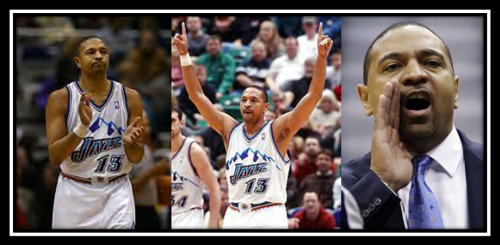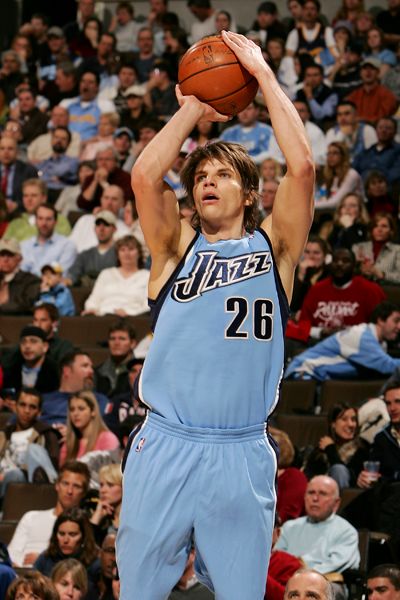
Did backup Mark Jackson actually attempt to turn the 2002-03 Utah Jazz locker room against Jazz starting point guard and future Hall-of-Famer John Stockton?
Background
During the 2002 NBA Draft, the Knicks traded Mark Jackson to the Denver Nuggets. The 37-year old quickly let it be known he had no interest in playing on a rebuilding Denver team that would eventually go 17-65, and negotiated a buyout before the start of training camp.
Utah’s 2001-02 backup PG John Crotty had a surprisingly effective season for the Jazz but missed 41 games including the postseason due to knee issues. In the 2002 offseason the Jazz let Crotty walk while penciling in 2001 1st-round pick, talented Raul Lopez, in to assume the backup role behind the 40-year old Stockton. That plan fell apart when Lopez re-injured his ACL in August, sending the Jazz scrambling. They signed a relative unknown in Carlos Arroyo, and then appeared to catch a break when Jackson and the Nuggets agreed to part ways.
The Jazz signed Mark Jackson on October 2, 2002. On that day, Jackson commented “I’m real excited to play for this team because of the class they have and the two Hall of Famers they have.” Jazz VP of Basketball Operations Kevin O’Connor remarked, “I think he wanted to play with a team that had veterans. He’s a veteran who knows how to play the game.”
The 2002-03 Jazz season was a roller-coaster. Utah started the season with DeShawn Stevenson and Andrei Kirilenko in the starting lineup, but the starting unit (including Stockton, Karl Malone and Greg Ostertag) could never seem to mesh. Amidst a 3-7 start, Jerry Sloan replaced Stevenson/Kirilenko with Calbert Cheaney and Matt Harpring in the starting lineup – and the Jazz suddenly vaulted themselves back into the playoff picture, ripping off streaks of 8-1 and 13-3 to find themselves sitting at 25-15 midway through January. Shortly after, Jerry Sloan would be assessed a 7-game league suspension for shoving referee Courtney Kirkland and the Jazz would go 21-17 the rest of the way.
The Attempted Coup
In April, the first reports of friction in the Jazz locker room leaked out, with Sports Illustrated’s Ian Thomsen writing:
[Stockton] may be getting a push out the door by his new backup this season and the No. 2 man on the career assist list, 38-year-old Mark Jackson. Three members of the Jazz organization now understand why Jackson has been traded seven times in his 16-year career: They say that over a period of weeks, he succeeded in turning several teammates against Stockton by repeatedly remarking that those players would be better off if Jackson were the Jazz’s floor leader. Other players* rallied around Stockton, who, because of his quiet nature, was vulnerable to the locker room politicking. The rift on the Jazz was mended, though not before Stockton’s pride had been wounded. “There was no question it hurt John, because you could see him withdraw,” says a high-ranking team official. “But he’ll never talk about it, just as he won’t talk about injuries, because then he feels like he’s making excuses for himself.”
Sloan reached a breaking point in mid-January, when he lost his temper over the divisiveness on his team and stormed out of the gym during practice. He was threatening to retire then and there, only to be dissuaded at an emergency meeting called by team owner Larry Miller, president Dennis Haslam, general manager Kevin O’Connor and Sloan’s wife, Bobbye. “That had the real potential of Jerry saying, ‘To heck with it,’ and walking away,” says Miller, who believes that Sloan’s seven-game suspension for shoving referee Courtney Kirkland on Jan. 28 was the result of his built-up frustrations.”
In 2003 the rumors of the “divide” were that Jackson politicked with several Jazz bench-warmers that they deserved more minutes and that the team needed to run more (with Jackson claiming to be better suited to play that style than Stockton) while Malone, Ostertag, and Harpring backed Sloan (and Stock).
Thomsen’s reports and these whispers were corroborated by Salt Lake Tribune columnist Steve Luhm, who in 2007 wrote:
“During his second season, Amaechi became a member of rebellious clique that also included Mark Jackson and DeShawn Stevenson.* They all were unhappy with the roles, and their discontent fractured a locker room that John Stockton and Karl Malone had run relatively smoothly for 15 years. Although Stockton never said anything to me, others insist that the off-the-court turmoil contributed to his decision to retire after the Jazz were eliminated from the 2003 playoffs.”
*Note: At practice during the 2003 Playoffs, Stevenson screamed and swore at Sloan for not playing him more in Game 1. Stevenson was suspended and sent home prior to Game 2, but made appearances in the following (and final) three games of the series. Years later, Stevenson grew to appreciate his first NBA coach, saying in 2010: “Playing with Jerry Sloan – Jerry’s a strict coach and we had our ups and downs, but I think he made me stronger as a player. He was tough, but he made me who I am now. If I didn’t go through that kind of system and that caliber of coach, I wouldn’t be in the NBA right now.”
Mark Jackson’s Response (via Ian Thomsen):
Jackson says his actions were in no way aimed at Stockton. “I’m a born leader, and if people take that as manipulation, then maybe they haven’t been around leaders,” he says. “I make no apologies for embracing people and talking to people and making them feel like they’re important. Maybe in the past those stray dogs have been left on the side, but that’s not the way I treat people.”
In John Stockton’s recently released “Assisted: An Autobiography,” he makes no mention of Mark Jackson but does cite that in his final seasons:
“Some of the older veterans who hadn’t been around our squad” … “…seemed to take offense to any player’s connection with the ‘brass,’ regardless of their history.” … “The grumbling created an undercurrent I hadn’t experienced at any other time of my career.”
The Best Source
There can be no better source than someone who was actually inside the 2003 Jazz lockerroom, and that’s exactly where former Jazz center Greg Ostertag was. No player has had more “run-ins” with Jerry Sloan, although eventually they both grew to respect and care for the other. In 2008, Greg Ostertag called into a radio show and spoke with Jazz host David Locke, in which Ostertag said Mark Jackson would “stir the pot” and the ever-classy Locke referenced Jackson as a 4-letter unprintable word.
Reading Between The Lines
In January 2003, Mark Jackson recorded the 10,000th assist of his career. He was asked by USA TODAY’s Greg Boeck “What does it mean to you to reach the 10,000-assist club with Johnson and Stockton?” In Jackson’s 79-word answer, he mentions “Magic” twice while never referring to Stockton by name, saying: “I’m a student of the game and I’m well aware of what those guys meant and mean to the game. To be a hundred or so assists away from Magic means more. If you would’ve told me when I was a kid in New York City, backing people down and trying to be Magic, I wouldn’t have believed it. This is a dream come true. I’m very blessed. I played with some great players (who) deserve a lot of credit.”
During Mark Jackson’s tenure as an ABC/ESPN analyst, he became the initial voice to champion the notion that Tim Duncan was the best power forward to ever play (misguided by the fact that Duncan is a center, Malone statistically was a better player, and that even today an overwhelming majority still hold Malone in higher regard). Additionally in a 2010 B.S. Report with Bill Simmons, while briefly analyzing the Utah Jazz Mark Jackson noted that Jerry Sloan’s distinguished record spoke for itself while slipping in a caveat that “I don’t agree” with Sloan’s coaching methods, before continuing on with his discussion.
Mark Jackson’s Credibility
Mark Jackson is a licensed minister who has been married to a gospel singer who is now his fellow pastor since 1990. In June of 2012, the then 47-year old Mark Jackson made headlines as victim of an extortion plot that revealed he had an extramarital affair with a 28-year old stripper in 2006. Jackson initially paid off the victim and her co-conpsiritor with $5,000 and Warriors tickets before eventually going to the FBI as the monetary demands continued.
Following the publicity, Mark Jackson issued this statement: “At that time in my life, I was not pastoring. Three years ago, my wife and I established a ministry. With deepest regret, I want to apologize to my church family. I was wrong. We must live holy.”
I’m not trying to judge another man’s faith, and for the sake of both Mark Jackson and his family I hope he has sincerely and truly turned the corner and put this mistake behind him. However, this incident’s lapse in judgment further exhibits a pattern of hypocrisy where Mark Jackson’s discreet actions belie his reverent words.
Mark Jackson’s 2014 Comments
When asked earlier this week by David Aldridge about the Stockton/Hornacek backcourt (which here at Jazzbasketball has been touted on the sidebar as “The NBA’s Best Shooting Backcourt” for going on a year now), Mark Jackson once again downplayed Stockton’s ability saying:
“Hornacek — great shooter. John Stockton — good to very good shooter. Not a great shooter. Don’t get me wrong. He was an all-time great player. But John Stockton would not be considered a great shooter.”
John Stockton was a career 52% shooter and shot 50% or better in 12 of his 19 seasons. Due to his role and unselfish nature, he may not have been the “prolific shooter” Jeff Hornacek was, but it is absurd for anyone to go out of their way to say Stock wasn’t a “great shooter” when virtually every statistic says otherwise.
I think it’s evident from all the smoking guns that Mark Jackson clearly played antagonistic role in Stockton’s final season, resented Jerry Sloan and his coaching decisions – and judging by his recent comments still holds some sort of grudge against Stockton. As someone infamously likes to say, “hand down, man down” – and Mark Jackson continues to sink lower with his clear bias against John Stockton.












